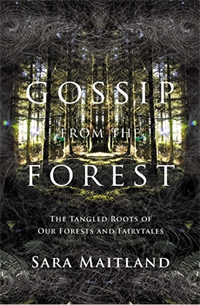 Why do forests capture our imagination? And why are so many fairytales, at least in the Northern European tradition, rooted in forests? Sara Maitland’s Gossip from the Forest is a fascinating and freewheeling exploration of how people shape the natural world, which shapes the tales we tell, which in turn shape us.
Why do forests capture our imagination? And why are so many fairytales, at least in the Northern European tradition, rooted in forests? Sara Maitland’s Gossip from the Forest is a fascinating and freewheeling exploration of how people shape the natural world, which shapes the tales we tell, which in turn shape us.
Maitland opens with the original meaning of the word ‘gossip’ (“one who has contracted a spiritual relationship to another, or a familiar acquaintance or friend”). As a feminist writer, she is reclaiming a term she believes has been trivialized to dismiss the power of women’s communication. (The American edition of the book has truncated the title to From the Forest, which is a shame.)
The chapters run from March through February, and in each Maitland visits a different forest in England or Scotland, and ends with a unique retelling of a familiar fairytale. There is much to ponder and to absorb. The descriptions of coppicing and pollarding were surprising to me, and I had to overcome my reflexive distaste for human interventions in the growth of forest trees. In a deciduous forest setting, these practices can be beneficial not only to humans (who need wood for fuel, building, and other uses) but to the trees as well. She notes that coppicing extends the lifespan of oaks, for example. Pollarding, which is done higher up on the tree, makes the thin branches accessible to humans but not to browsing deer and other mammals.
Another observation that intrigued me was the venerated position beech trees hold in British culture (see Richard Mabey’s book Beechcombings, or the widespread use of beeches in private estates to “posh up the landscape,” to quote the book) compared to the birch, which the author prefers for its aesthetic and useful qualities. Beech is thought of as native, but is widespread across Europe; in Britain it mainly grows in the southern half of the country. She recalls her father’s saying that “tyranny is like a beech tree; it looks very fine but nothing grows under it.”
This is a book with a wide reach. Maitland touches on the history of the powerful and the powerless as evidenced in policies like enclosure (ending public rights and access to land which was once held in common), and on the cultural and psychological underpinnings of tales in which common folk are skilled and wise while kings are fools and landed gentry are consumed by greed. Her walks through the forest evoke the mystery of the natural world and the stories we tell to understand our place in it. Adam Lee, Maitland’s son (who took the photographs which accompany the text), provides a useful image which summarizes the essence of the book: fairytales, forests, and people are interdependent, like mycorrhizae and tree roots.
Reviewed by Rebecca Alexander
 Excellent photographs are the outstanding quality of “Uncommon Beauty”, a new field guide focused on an underexplored part of the Pacific Northwest — southeastern British Columbia. Written by an enthusiastic outdoorsman and native of the area, Neil L. Jennings provides a very readable description of over 200 plants, many who have ranges that extend southward into eastern Washington.
Excellent photographs are the outstanding quality of “Uncommon Beauty”, a new field guide focused on an underexplored part of the Pacific Northwest — southeastern British Columbia. Written by an enthusiastic outdoorsman and native of the area, Neil L. Jennings provides a very readable description of over 200 plants, many who have ranges that extend southward into eastern Washington. Based on his earlier, high-energy books, it is not hard to imagine Des Kennedy as the author of book entitled
Based on his earlier, high-energy books, it is not hard to imagine Des Kennedy as the author of book entitled  Here in Seattle, we have our picturesque and productive P-Patches. In England, allotment gardens trace their roots to the policies of enclosure of open fields which had been held in common, and to industrialization and burgeoning urban populations. This fencing in and privatization began as early as the 14th century but was widespread through the 18th and 19th centuries, when allotments were offered as a small compensation to villagers and city dwellers who did not own private land.
Here in Seattle, we have our picturesque and productive P-Patches. In England, allotment gardens trace their roots to the policies of enclosure of open fields which had been held in common, and to industrialization and burgeoning urban populations. This fencing in and privatization began as early as the 14th century but was widespread through the 18th and 19th centuries, when allotments were offered as a small compensation to villagers and city dwellers who did not own private land. Bulb season is upon us—time to consider forcing a few for winter indoor color. Amongst the many bulb books in the Miller Library are a handful that focus on this delightful art.
Bulb season is upon us—time to consider forcing a few for winter indoor color. Amongst the many bulb books in the Miller Library are a handful that focus on this delightful art. Why do forests capture our imagination? And why are so many fairytales, at least in the Northern European tradition, rooted in forests? Sara Maitland’s
Why do forests capture our imagination? And why are so many fairytales, at least in the Northern European tradition, rooted in forests? Sara Maitland’s 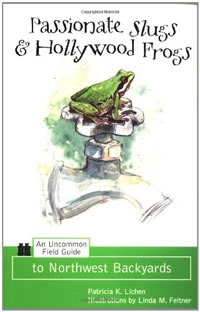 With a title like “Passionate Slugs and Hollywood Frogs,” it’s hard to know what to expect from the 2001 book by Patricia K. Lichen, but the sub-title helps: “An Uncommon Field Guide to Northwest Backyards.” This is mainly a guide to the birds and other animals–natives and non-natives alike–who may call your backyard home, plus a few plants including iconic trees, some troublesome invasives, and even your lawn and its “three million tiny plants.” The essays are short and full of whimsy, but also plenty of good information and the incentive to appreciate what you have in your own, well, backyard. The book concludes with an invitation to look up and appreciate rainbows and the stars at night–charming.
With a title like “Passionate Slugs and Hollywood Frogs,” it’s hard to know what to expect from the 2001 book by Patricia K. Lichen, but the sub-title helps: “An Uncommon Field Guide to Northwest Backyards.” This is mainly a guide to the birds and other animals–natives and non-natives alike–who may call your backyard home, plus a few plants including iconic trees, some troublesome invasives, and even your lawn and its “three million tiny plants.” The essays are short and full of whimsy, but also plenty of good information and the incentive to appreciate what you have in your own, well, backyard. The book concludes with an invitation to look up and appreciate rainbows and the stars at night–charming.
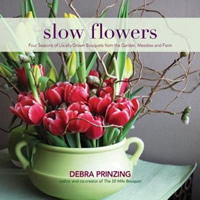 “Slow Flowers” is something of a sequel to “The 50 Mile Bouquet,” Debra Prinzing’s previous book (co-created with photographer David Perry) about local and sustainable cut flower vendors. In this book, she uses the produce (flowers, leaves, seedpods, cones, and other plant material) from those vendors, plus cuttings from her own yard and those of friends to create a calendar full of arrangements, one for each week of the year.
“Slow Flowers” is something of a sequel to “The 50 Mile Bouquet,” Debra Prinzing’s previous book (co-created with photographer David Perry) about local and sustainable cut flower vendors. In this book, she uses the produce (flowers, leaves, seedpods, cones, and other plant material) from those vendors, plus cuttings from her own yard and those of friends to create a calendar full of arrangements, one for each week of the year.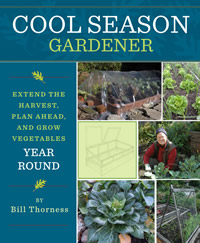
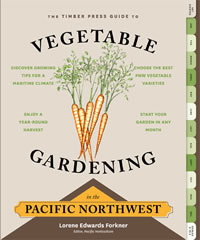 In “The Timber Press Guide to Vegetable Gardening in the Pacific Northwest,” Lorene Edwards Forkner gives a whole calendar of ideas of what to plant and what to harvest every month–what’s unusual is that the chapter on January, while having fewer pages, is still on equal footing with June, rather than be relegated to an off-season category.
In “The Timber Press Guide to Vegetable Gardening in the Pacific Northwest,” Lorene Edwards Forkner gives a whole calendar of ideas of what to plant and what to harvest every month–what’s unusual is that the chapter on January, while having fewer pages, is still on equal footing with June, rather than be relegated to an off-season category.